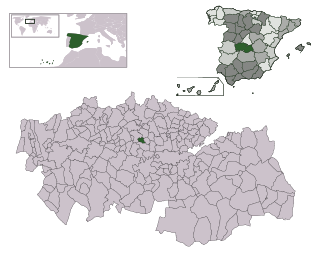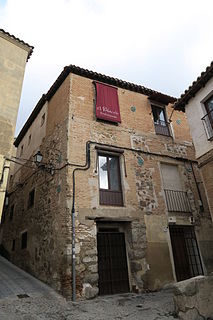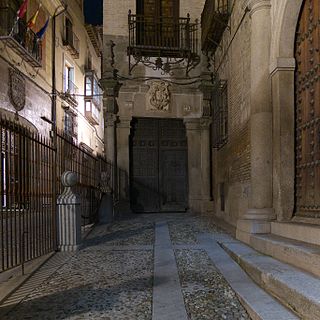This article relies largely or entirely on a single source .(July 2017) |

The Palacio de Benacazón is a palace located in the city of Toledo, in Castile-La Mancha, Spain.

Toledo is a city and municipality located in central Spain; it is the capital of the province of Toledo and the autonomous community of Castile–La Mancha. Toledo was declared a World Heritage Site by UNESCO in 1986 for its extensive monumental and cultural heritage.

Spain, officially the Kingdom of Spain, is a country mostly located in Europe. Its continental European territory is situated on the Iberian Peninsula. Its territory also includes two archipelagoes: the Canary Islands off the coast of Africa, and the Balearic Islands in the Mediterranean Sea. The African enclaves of Ceuta, Melilla, and Peñón de Vélez de la Gomera make Spain the only European country to have a physical border with an African country (Morocco). Several small islands in the Alboran Sea are also part of Spanish territory. The country's mainland is bordered to the south and east by the Mediterranean Sea except for a small land boundary with Gibraltar; to the north and northeast by France, Andorra, and the Bay of Biscay; and to the west and northwest by Portugal and the Atlantic Ocean.
This palace is one of the most representative examples of the typical houses of Toledo. Its courtyard is of Mudéjar style, together with its decoration, based on plasterwork and azulejos, are its main attractions. Over time it has undergone numerous restorations.
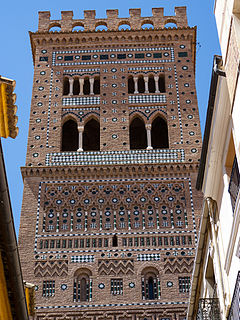
Mudéjar refers to a style of ornamentation and decoration in post-Islamic Christian Iberia that was strongly influenced by Moorish taste and workmanship. Historically, the term also applies to the large group of Muslims who remained in Iberia in the late medieval period despite the Christian reconquest.

Azulejo is a form of Portuguese and Spanish painted tin-glazed ceramic tilework. Azulejos are found on the interior and exterior of churches, palaces, ordinary houses, schools, and nowadays, restaurants, bars and even railways or subway stations. They were not only used as an ornamental art form, but also had a specific functional capacity like temperature control in homes.
The palace that currently bears the name of Palacio de Benacazón in Toledo is, probably from the time of Peter of Castile the Cruel, was also the seat of the Holy Office (the Inquisition). Former property of Fernán Pérez de Pantoja, it was manor house of the Pantoja and the Gaytán families, being called from the 16th century like Palacio de los Pantoja. It is between 1920 and 1940. Anastasio Páramo Barranco, who was the only descendant, gave himself before he died the name of Anastasio Páramo y Pantoja Cepeda, as well as the titles of Count of Benacazón, Lord of Mocejón and Benacazón. In the sixties it was Medical Consultation Center. [1]
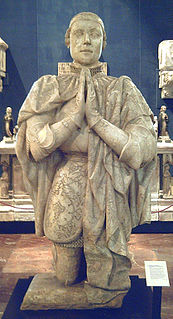
Peter, called the Cruel or the Just, was the king of Castile and León from 1350 to 1369. Peter was the last ruler of the main branch of the House of Ivrea.
It is currently the headquarters of the Caja Castilla-La Mancha Foundation, a cultural center where stage arts are performed.

